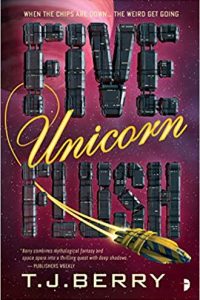Gwenda Bond reviews Greg van Eekhout
 In the opening scene of Greg van Eekhout’s optimistic post-apocalyptic fable (something we could use more of) for middle grade readers, The Boy at the End of the World, Fisher awakes in a bubbling pod, disconnects his umbilical cord, and realizes two things: that the world is dangerous and he is alone. These things prove both true and untrue. That this world is dangerous is indisputable: Fisher ‘‘became born’’ surrounded by a tableau of active and complete destruction in the Ark he inhabits. But while fleeing the chaotic scene of falling ceilings and shattered life-support pods, he discovers he’s not exactly alone. A damaged robot hails him, and though Fisher at first runs from what he perceives as a threat, soon enough he welcomes his new companion, christening the robot Click. Though a custodial robot, Click’s programming still gives him a mandate to protect and help Fisher – an impulse that often feels parental – and some background knowledge of the Ark’s purpose and the larger world. And Fisher has his own programming. Click has given him the ‘‘Fisher’’ personality profile, with all its specific knowledge and skills, and limitations. Will Fisher be able to stay alive with this skill set, facing evolved threats like murderous giant parrots and rats?
In the opening scene of Greg van Eekhout’s optimistic post-apocalyptic fable (something we could use more of) for middle grade readers, The Boy at the End of the World, Fisher awakes in a bubbling pod, disconnects his umbilical cord, and realizes two things: that the world is dangerous and he is alone. These things prove both true and untrue. That this world is dangerous is indisputable: Fisher ‘‘became born’’ surrounded by a tableau of active and complete destruction in the Ark he inhabits. But while fleeing the chaotic scene of falling ceilings and shattered life-support pods, he discovers he’s not exactly alone. A damaged robot hails him, and though Fisher at first runs from what he perceives as a threat, soon enough he welcomes his new companion, christening the robot Click. Though a custodial robot, Click’s programming still gives him a mandate to protect and help Fisher – an impulse that often feels parental – and some background knowledge of the Ark’s purpose and the larger world. And Fisher has his own programming. Click has given him the ‘‘Fisher’’ personality profile, with all its specific knowledge and skills, and limitations. Will Fisher be able to stay alive with this skill set, facing evolved threats like murderous giant parrots and rats?
The proof that humanity is fragile is all around them, as they try to ‘‘continue existing’’ in a landscape of devastation dotted with the remnants and ruins of society and its collapse. Click’s history reveals that humans were destroyed by an accumulation of unintended consequences when they tried to alter nature and preserve their environment. It seems that Fisher may well be the only human left on this Earth. Before too long, Fisher and Click pick up a third companion, in the form of a constantly dung-dropping small mammoth whom Fisher names Protein (he first considered killing him). They also pick up a new goal, in addition to surviving: to travel to another Ark in the hope of resurrecting more human – and other – life. The trip down the Mississippi on a raft – a recasting of Mark Twain’s great American journey narrative with a boy, robot, and mammoth – yields dangerous foes in the form of less friendly robots. They encounter yet more combative technology, numerous evolved animal and plant threats, and, finally, a talking race of prairie dogs created through human experimentation that knows the way to the Western Ark. There, a final battle is waged, and an even bigger decision is made about the future.
If this all sounds like an outlandish mix, it can be at times, but van Eekhout fills out his world with scientific explanations and internal consistency that makes it add up to more than a series of wacky perils faced by our heroes. The innate humor in Fisher’s naive, yet clever point of view – ‘‘Profanity was a collection of words that helped express strong feelings. Fisher uttered a word from his profanity collection now’’ – and in the way van Eekhout constructs the story helps support the underlying optimism about the ability of humans and other creatures to work together to get things right, and not just wrong. Which isn’t to say there’s not plenty of pathos in Fisher’s situation and in his world. This novel is as much a part of the survival story tradition as the post-apocalyptic one, and the big philosophical questions Fisher grapples with are not simple or funny. Young readers love to watch a protagonist locked in a primal battle for survival – witness examples as far apart tonally as Hatchet and Tarzan of the Apes – and this book very much connects on that level.
Fans of van Eekhout’s previous works, Norse Code for adults and Kid vs. Squid for younger readers, will definitely want to check this out, but it should also lure in many new readers. The sure-footed pacing, deft balance of humor with serious, memorable characters, and well-crafted action sequences combine to make this van Eekhout’s most accomplished work to date. Cormac McCarthy, take note: not every post-apocalypse must be unrelentingly grim.







